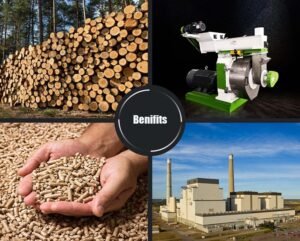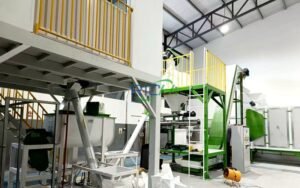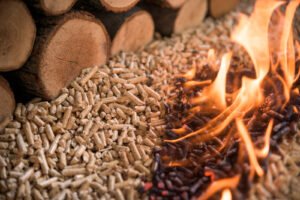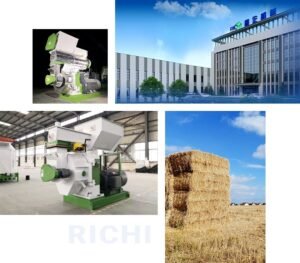
The Grass Pellet Machine, despite its name, is a versatile piece of equipment capable of processing a wide variety of materials into pellets. While primarily designed for grass, these machines can handle numerous types of biomass and agricultural residues. This article explores the range of raw materials that can be effectively pelletized using a Grass Pellet Machine, highlighting its versatility and potential applications in various industries.
- Grass
As the name suggests, the primary material processed by this machine is grass:
- Various types of lawn grass
- Wild grasses
- Pasture grasses
- Ornamental grasses
Grass pellets can be used for animal feed, biomass fuel, or as organic fertilizer.
- Hay
Similar to grass, different types of hay can be effectively pelletized:
- Alfalfa hay
- Timothy hay
- Meadow hay
- Mixed hay varieties
Hay pellets are commonly used as animal feed, particularly for livestock such as cattle, horses, and rabbits.
- Straw
Straw from various crops can be processed into pellets:
- Wheat straw
- Rice straw
- Barley straw
- Oat straw
Straw pellets have multiple uses, including animal bedding, biomass fuel, and as a raw material for various industrial processes.
Related post: Straw Pellet Mill
- Agricultural Residues
Many agricultural byproducts and residues can be pelletized:
- Corn stalks and cobs
- Soybean stalks
- Sunflower stalks
- Cotton stalks
- Peanut shells
- Rice husks
These pellets can serve as animal bedding, biomass fuel, or as components in animal feed formulations.
- Leaves
Fallen leaves, often considered waste, can be processed into pellets:
- Deciduous tree leaves
- Pine needles
Leaf pellets can be used as organic mulch, compost material, or as a component in some biomass fuel blends.
- Wood Sawdust
Many Grass Pellet Machines can also process wood-based materials:
- Sawdust from various wood types
- Wood shavings
- Fine wood chips
Wood pellets are primarily used as a renewable heating fuel but also find applications in animal bedding and industrial processes.
- Herbaceous Energy Crops
Certain crops grown specifically for biomass can be pelletized:
- Switchgrass
- Miscanthus
- Reed canary grass
These pellets are often used for bioenergy production.
- Legumes
Various leguminous plants can be processed:
- Clover
- Vetch
- Lespedeza
Legume pellets are valuable as high-protein animal feed.
- Crop Residues
Residues from food crop production can be pelletized:
- Sugar cane bagasse
- Olive pomace
- Coffee husks
These pellets can be used for animal bedding, biomass fuel, or as organic fertilizers.
- Aquatic Plants
Some aquatic plants can be harvested and pelletized:
- Water hyacinth
- Duckweed
- Algae
These pellets can be used for animal feed, biofuel, or as organic fertilizers.
- Mixed Biomass
The Grass Pellet Machine often allows for the mixing of different biomass materials:
- Combinations of various agricultural residues
- Mixtures of grass, straw, and wood materials
Mixed biomass pellets can be tailored for specific applications, balancing factors like energy content, ash content, and cost.Advantages of Using Grass Pellet Machines for Various MaterialsThe ability of Grass Pellet Machines to process such a wide range of materials offers several advantages:
- Versatility: Operators can switch between different raw materials based on availability and market demand.
- Waste Reduction: Agricultural and industrial byproducts can be converted into valuable products.
- Value Addition: Low-value residues can be transformed into higher-value pelletized products.
- Improved Handling: Pelletization makes materials easier to store, transport, and use.
- Enhanced Efficiency: Pellets often offer improved combustion efficiency when used as fuel compared to raw biomass.
Considerations for Processing Different MaterialsWhile Grass Pellet Machines are versatile, some considerations are necessary when processing different materials:
- Moisture Content: Different materials have varying optimal moisture levels for pelletization. Generally, a moisture content of 10-15% is ideal for most materials.
- Particle Size: Some materials may require additional grinding or preprocessing to achieve the optimal particle size for pelletization.
- Binding Properties: Certain materials may require binders or additives to form stable pellets. Natural lignin content in the material can act as a binder.
- Die Selection: Different materials may require specific die configurations for optimal pellet formation. Die hole size and compression ratio may need to be adjusted.
- Machine Adjustments: Settings like pressure and temperature may need adjustment for different materials to achieve the best pellet quality.
- Pretreatment: Some materials may benefit from pretreatment processes like steam conditioning to improve pelletization.
Potential Applications of Pellets from Various MaterialsThe pellets produced from these diverse raw materials have a wide range of applications:
- Animal Feed: Pellets from grass, hay, legumes, and some crop residues are excellent for livestock and poultry feed.
- Biomass Fuel: Pellets from wood sawdust, straw, and energy crops are commonly used in pellet stoves and industrial boilers.
- Organic Fertilizer: Pellets from leaves, aquatic plants, and some agricultural residues can be used as slow-release organic fertilizers.
- Animal Bedding: Straw pellets and wood pellets are popular choices for animal bedding.
- Industrial Processes: Some pellets find use in industrial applications, such as in the production of fiberboard or as absorbents.
Conclusion
The Grass Pellet Machine demonstrates remarkable versatility in its ability to process a wide range of raw materials into pellets. From various types of grass and agricultural residues to wood-based materials and specialized energy crops, these machines offer a flexible solution for converting biomass into more manageable and valuable forms.This versatility makes Grass Pellet Machines valuable assets in various industries, including agriculture, animal husbandry, renewable energy, and waste management. By effectively pelletizing different materials, these machines contribute to more efficient resource utilization, waste reduction, and the creation of value-added products from what might otherwise be considered low-value or waste materials.
As the demand for sustainable practices and efficient resource utilization continues to grow, the importance of versatile processing equipment like Grass Pellet Machines is likely to increase. Their ability to handle a diverse range of input materials positions them as key tools in the ongoing transition towards more circular and sustainable economic models in agriculture and related industries.
For operators considering the use of Grass Pellet Machines for diverse materials, it’s crucial to understand the specific characteristics of each raw material and how they might affect the pelletization process. Proper machine setup, material preparation, and quality control are essential for producing high-quality pellets from any raw material. With the right approach, Grass Pellet Machines can be powerful tools for transforming a wide array of biomass resources into valuable, easy-to-handle pellets for various applications.





